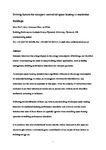Driving factors for occupant-controlled space heating in residential buildings
| dc.contributor.author | Wei, S | |
| dc.contributor.author | Jones, Rory | |
| dc.contributor.author | de Wilde, Pieter | |
| dc.date.accessioned | 2016-02-12T17:11:18Z | |
| dc.date.available | 2016-02-12T17:11:18Z | |
| dc.date.issued | 2014-02 | |
| dc.identifier.issn | 0378-7788 | |
| dc.identifier.issn | 1872-6178 | |
| dc.identifier.uri | http://hdl.handle.net/10026.1/4319 | |
| dc.description.abstract |
Occupant behaviour has a large impact on the energy consumption of buildings, and therefore a better understanding can assist in many building-related applications, such as facility management, building performance simulation and occupant guidance. As occupant space-heating operation has a significant influence on the energy consumption of residential buildings in winter, an investigation of drivers for this behaviour was undertaken and the result is expressed in this paper. From the analysis, 27 drivers have been evaluated in previous behavioural studies and at present none of them can be identified confidently as having no influence. Following the identification of these key drivers, the modelling of occupant space-heating behaviour in traditional building performance simulation was reviewed and the result indicates that most of these factors are typically ignored when modelling space-heating operation in building performance simulation. It is concluded that future behavioural studies into the drivers discussed in this paper are needed to gain a better understanding and quantification of the impact of these factors on building energy use. © 2013 Elsevier B.V. | |
| dc.format.extent | 36-44 | |
| dc.language | en | |
| dc.language.iso | en | |
| dc.publisher | Elsevier BV | |
| dc.subject | Occupant behaviour | |
| dc.subject | Space heating drivers | |
| dc.subject | Energy consumption | |
| dc.subject | Residential buildings | |
| dc.subject | Building simulation | |
| dc.title | Driving factors for occupant-controlled space heating in residential buildings | |
| dc.type | journal-article | |
| dc.type | Article | |
| plymouth.author-url | http://www.sciencedirect.com/science/article/pii/S037877881300683X | |
| plymouth.issue | 0 | |
| plymouth.volume | 70 | |
| plymouth.publication-status | Published | |
| plymouth.journal | Energy and Buildings | |
| dc.identifier.doi | 10.1016/j.enbuild.2013.11.001 | |
| plymouth.organisational-group | /Plymouth | |
| plymouth.organisational-group | /Plymouth/Faculty of Arts, Humanities and Business | |
| plymouth.organisational-group | /Plymouth/Faculty of Arts, Humanities and Business/School of Art, Design and Architecture | |
| plymouth.organisational-group | /Plymouth/REF 2021 Researchers by UoA | |
| plymouth.organisational-group | /Plymouth/REF 2021 Researchers by UoA/UoA13 Architecture, Built Environment and Planning | |
| plymouth.organisational-group | /Plymouth/Users by role | |
| plymouth.organisational-group | /Plymouth/Users by role/Academics | |
| dcterms.dateAccepted | 2013-11-01 | |
| dc.identifier.eissn | 1872-6178 | |
| dc.rights.embargoperiod | Not known | |
| rioxxterms.funder | Engineering and Physical Sciences Research Council | |
| rioxxterms.identifier.project | EPSRC Transforming Energy Demand in Buildings through Digital Innovation (BuildTEDDI) Scheme | |
| rioxxterms.versionofrecord | 10.1016/j.enbuild.2013.11.001 | |
| rioxxterms.licenseref.uri | http://www.rioxx.net/licenses/all-rights-reserved | |
| rioxxterms.licenseref.startdate | 2014-02 | |
| rioxxterms.type | Journal Article/Review | |
| plymouth.funder | EPSRC Transforming Energy Demand in Buildings through Digital Innovation (BuildTEDDI) Scheme::Engineering and Physical Sciences Research Council |


